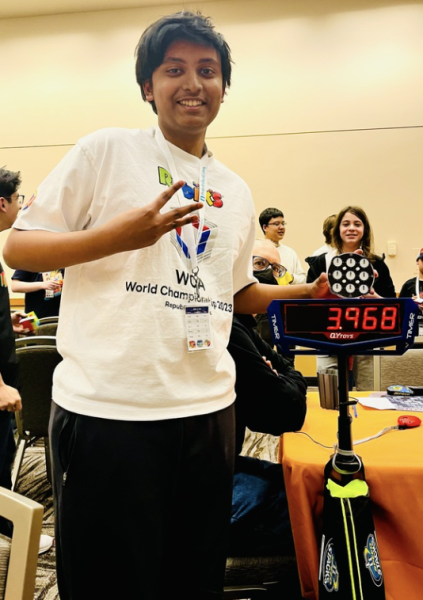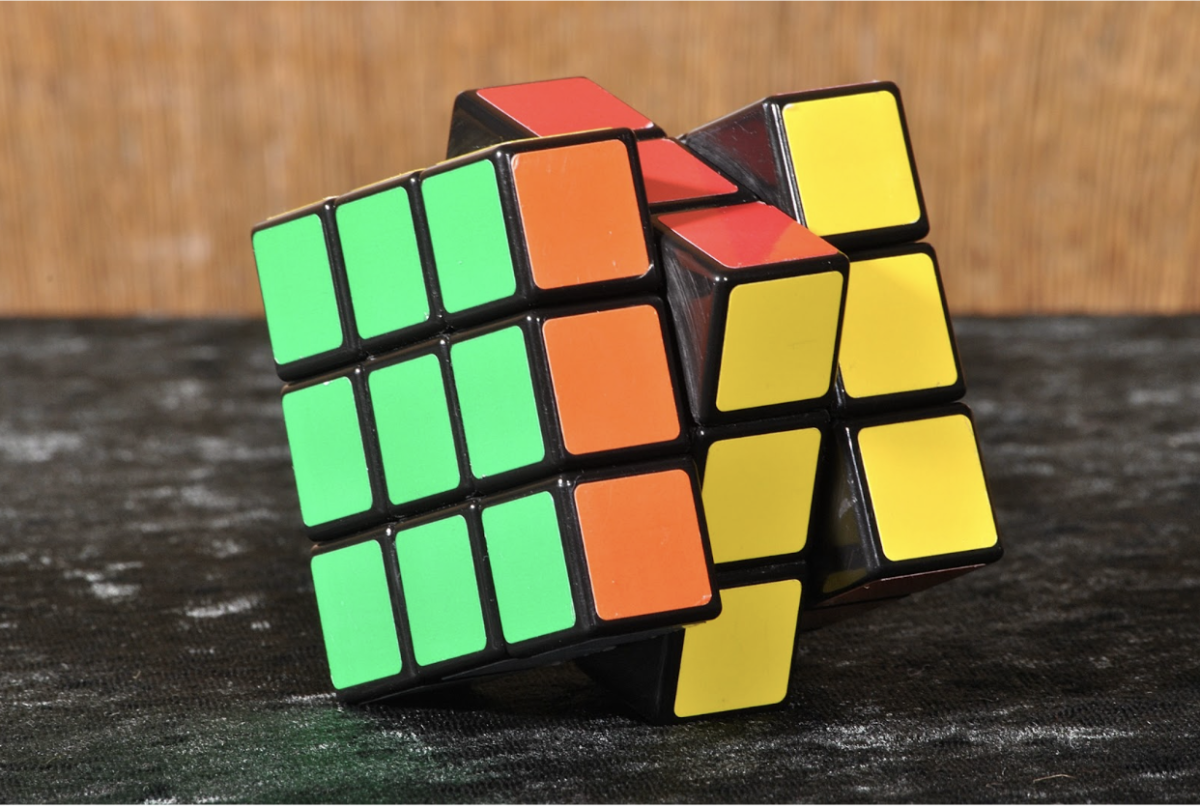Unveiled in 1974 by Hungarian architect Ernő Rubik, the Rubik’s Cube is more than just a toy: it is a cultural icon that has both puzzled and fascinated millions. The puzzle captivates you with its vibrant colors and intricate mechanism, but it remains an enigma to most after just a few turns.
Only around 5.8% of the world’s population knows how to solve a Rubik’s cube. The OHS Community has a Rubik’s Cube Club with 20 members, ranging from beginners who average around 1-2 minutes to advanced solvers who can finish in less than 15 seconds. But above them all stands one of the fastest and most experienced cubers, Mihir Rai.
Mihir is a full-time junior from Bothell, Washington. While he mainly dedicates his time to cubing, his other pursuits include competitive math, programming in C++ and Java, and even occasional tennis games.
“So I first learned how to solve the Rubik’s cube in fifth grade,” Mihir says. “These two kids in my class, they knew how to solve it. So they both brought it to school and they were impressing everybody.”
Mihir’s competitive spirit fueled him to do the same: “What puts me so close to speed cubing is that I’m super competitive. I see that they’re getting so much attention from doing this, and so I decided that I need to learn how to solve a cube too. I went home, watched a really good tutorial, and I learned it after 2 weeks.”
Since then, Mihir has been steadily improving and has officially competed in 21 competitions organized by the World Cube Association (WCA) and has even organized two competitions himself: “I organized one in July and one a few weeks ago. Both were really fun experiences working with other official organizers and delegates.”
Last summer, Mihir went to the WCA World Championships 2023 in Seoul, South Korea, the main international competition held every two years. He recalls how it was one of the most memorable and fun experiences he’s had: “It was incredible to participate and meet cubers and great people like Feliks Zemdegs, Max Park, and a bunch of national continental record holders. And to compete in front of a massive stage in front of everybody, it was quite something.”
Of course, every journey, no matter how fulfilling, is accompanied by its unique set of challenges and hurdles. In the realm of cubing, these challenges are not just about mastering algorithms: they extend to mental resilience and continuous learning. “The process of improvement can be very tough,” Mihir says. “It is not an exponential growth, it is more logarithmic. When going from 10 to 9 seconds, decreasing your time by even a second can take months or years of work. It can definitely be demotivating sometimes if you’ve been stuck at one level for a long period of time and you don’t know if you will improve.”
However, these inherent challenges also cultivate one’s passion for cubing. The thrill that comes with continual improvement mixed with the sense of community it fosters naturally moves people: “What drives me to cube is my competitiveness. Just the idea of going to competitions, having official results and seeing my names come up on the rankings page is exciting, especially if I see myself as third, second, or first,” Mihir says. “Also nobody will be mean to you because you’re slow or something, there’s no judgement. The cubing community is incredibly supportive, and it is definitely why a lot of people cube.”
This is what makes the cubing community so unique. In any competitive environment, the desire to beat others can drive a sense of toxicity. In cubing, it is more about improving upon yourself and sharing the collective joy of each other’s successes. Competitors often find themselves cheering for one another, offering tips, and celebrating personal milestones together.
Mihir also explains how these experiences have taught him valuable lessons outside of the cubing realm: “I think creativity and critical thinking are important. For a scramble, you might think about several different solutions and ways to become more efficient. In the real world, if you have a problem, you might consider different ways to tackle and resolve it.”
While the cubing community thrives on improvement, encouragement, and creativity, there are still widespread misconceptions for those who are unfamiliar with it. These often stem from the stigma that one needs an exceptionally high IQ, which overshadows the true nature of cubing. Mihir shares some of his thoughts on this:
“I think if you never see a tutorial, you just see a cube with many colors mixed up and you don’t know where to start. It obviously seems impossible, but all you have to do is just search up a tutorial and follow it systematically no matter how long it takes. There’s no cheat code of solving one side at a time, and the beginner’s method might not be the most intuitive thing to find out initially, but it is the first step to success.”
Mihir’s approach to cubing extends beyond just personal practice and competitions. Recognizing the power of sharing his knowledge and favorite moments to inspire others, he has currently uploaded more than 60 videos on his YouTube channel, Cubephile: “I was focused on making cubing entertainment content in around eighth grade, and I also put some tutorials for F2L, PLL , etc. Midway through ninth grade, my time was much more devoted to school, so now I mostly upload my best solves and personal records from competitions.”
As Mihir continues to improve and excel in cubing, he currently stands at an exciting crossroad. With his wealth of experience, he is poised to set ambitious goals for himself and confront new challenges. He shares some of his favorite Rubik’s puzzles and aspirations for the future:
“I really like 3×3 one-handed because you can apply so many more techniques with finger tricks and algorithms. Although it is not as popular, I also like Clock because it is very analytical and involves a bit of math. I also enjoy doing Pyraminx, as I am getting quite good at it as well. So I am competing at the 2024 North American Championships and I am grinding Pyraminx. I want to practice a lot and hopefully podium or even make finals.”




Frank • Jul 15, 2024 at 12:09 pm
Is the cube scrambled